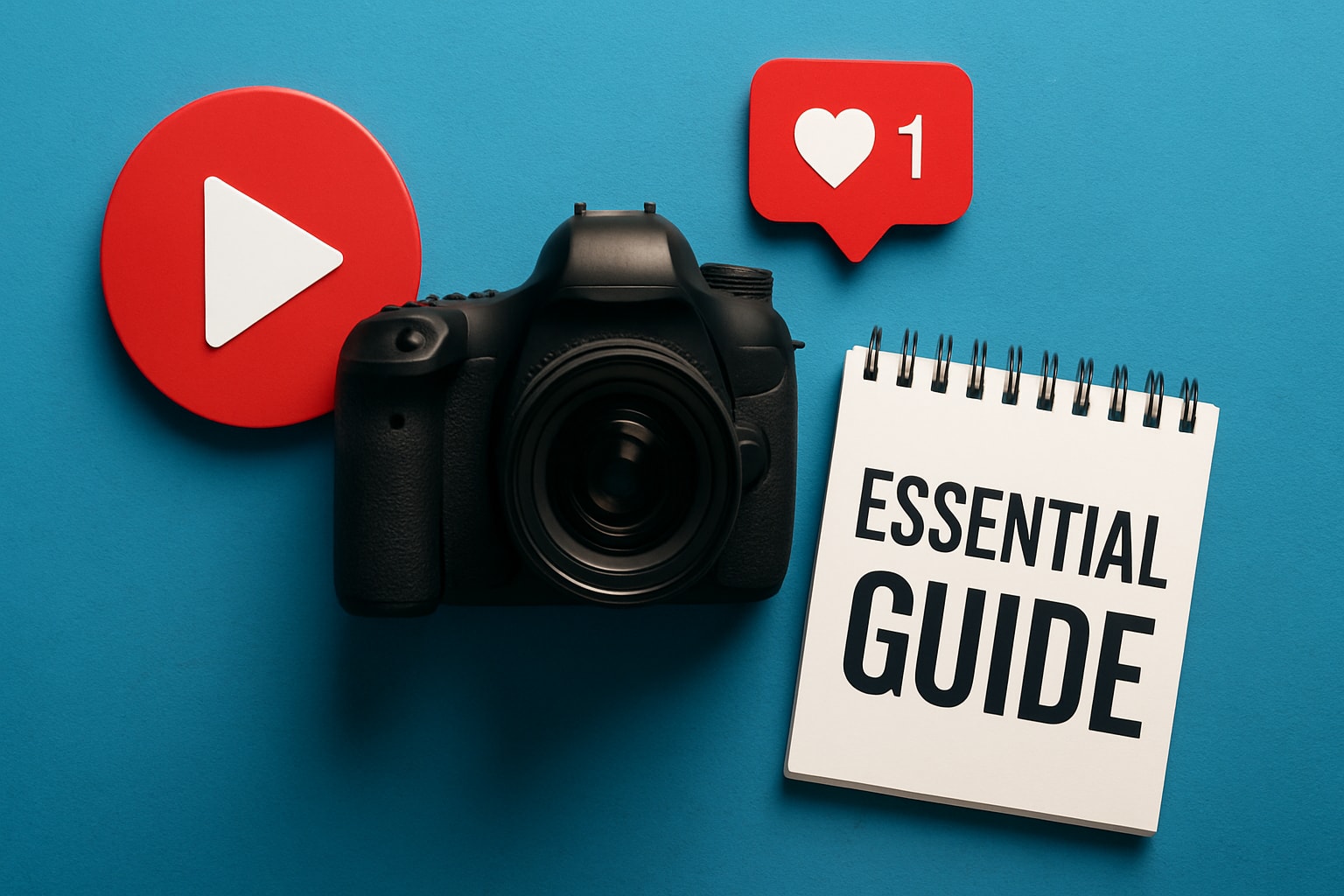Did you know that by 2025, video will account for 82% of all online traffic? The surge of dynamic video content on social media is reshaping how we connect, share, and influence.
This guide is your roadmap to mastering videography for social media in 2025. We will blend creative storytelling, cutting-edge technology, and proven strategies to help your videos truly stand out.
Here’s what you can expect:
- The latest trends and audience behaviors
- Must-have tools and gear for creators
- Creative planning and production techniques
- Platform-specific best practices
- Future-proof workflows for social video success
Get ready for actionable insights and practical steps that will empower you to capture attention, drive engagement, and grow your presence through videography for social media.
The Evolution of Social Media Videography in 2025
Social feeds are bursting with motion and color, and videography for social media is evolving at breakneck speed. Just a few years ago, a simple video might have gone viral. Now, creators and brands are navigating a complex landscape shaped by shifting audiences, cutting-edge tech, and nonstop innovation. To master videography for social media in 2025, you need to understand how these forces are transforming the way stories are told and watched.
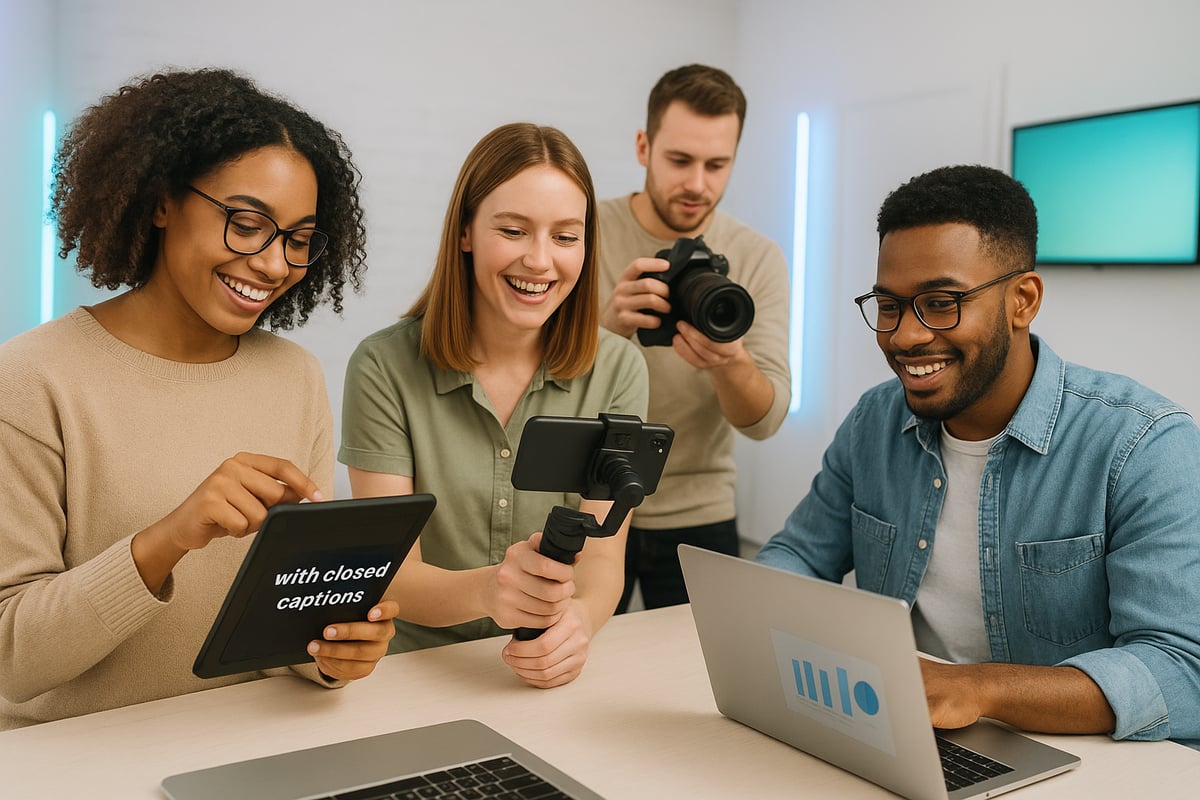
Shifting Audience Behaviors and Expectations
Audiences in 2025 are more selective than ever, and their appetite for quick, genuine content continues to grow. Short-form videos dominate, with platforms like TikTok, Instagram Reels, and YouTube Shorts setting the pace. Viewers crave authenticity, flocking to behind-the-scenes peeks, unfiltered moments, and creators who feel real—not rehearsed.
Interactivity has also become a must. Polls, live Q&As, and shoppable videos are now part of everyday scrolling. Silent viewing is the norm, so captions are critical. In fact, 85% of Facebook videos are watched without sound, highlighting just how much captions drive engagement. For a deeper dive into these trends, check out these Social Media Video Marketing Statistics 2025.
Every successful creator knows that videography for social media is about meeting audiences where they are—quick, interactive, and accessible.
Emerging Technologies Impacting Videography
The tools behind videography for social media have undergone a revolution. AI-powered editing platforms are making it easier to produce polished content in record time. Imagine trimming, captioning, and enhancing a video with just a few taps—AI does the heavy lifting so creators can focus on storytelling.
Augmented reality and virtual reality filters are everywhere, transforming ordinary clips into immersive experiences. Smartphone cameras now shoot in 8K and handle low light like pros, while built-in stabilization lets anyone capture smooth footage. Cloud-based collaboration tools empower teams to work together from anywhere, editing and reviewing in real time.
Instagram’s new AI-driven video templates, introduced in 2024, are a game changer, letting creators match trends and styles instantly. As technology advances, videography for social media becomes more accessible and creative than ever.
Data-Driven Creativity and Performance
In 2025, the art and science of videography for social media are inseparable. Creators rely on analytics to shape their video strategies, using real-time data to understand what resonates. A/B testing different video formats helps pinpoint what hooks viewers and keeps them watching.
Personalization is also at the forefront. By analyzing viewer behavior, brands and influencers tailor content to individual preferences, increasing retention and shares. TikTok’s robust insights let creators track trends and adapt quickly, turning viral moments into long-term growth.
Harnessing data means creators can be both strategic and creative, continually refining their approach to videography for social media and maximizing every post’s potential.
Key Takeaway: Adapting to Stay Ahead
The secret to thriving in videography for social media is adaptability. Platforms, features, and audience tastes evolve fast, so continuous learning is essential. Creators who experiment with new formats, test fresh ideas, and embrace new tech stay ahead of the curve.
Agility is your best asset. Whether you are a solo creator or a brand team, being willing to pivot and try new things ensures your videography for social media remains fresh and relevant.
Stay curious, keep experimenting, and remember: the only constant in social video is change.
Essential Gear, Software, and Tools for 2025 Social Video
The landscape of videography for social media is evolving at lightning speed. In 2025, creators are not just storytellers, but also tech enthusiasts, strategists, and innovators. The right tools can transform a simple idea into a viral sensation, making gear and software choices more crucial than ever.
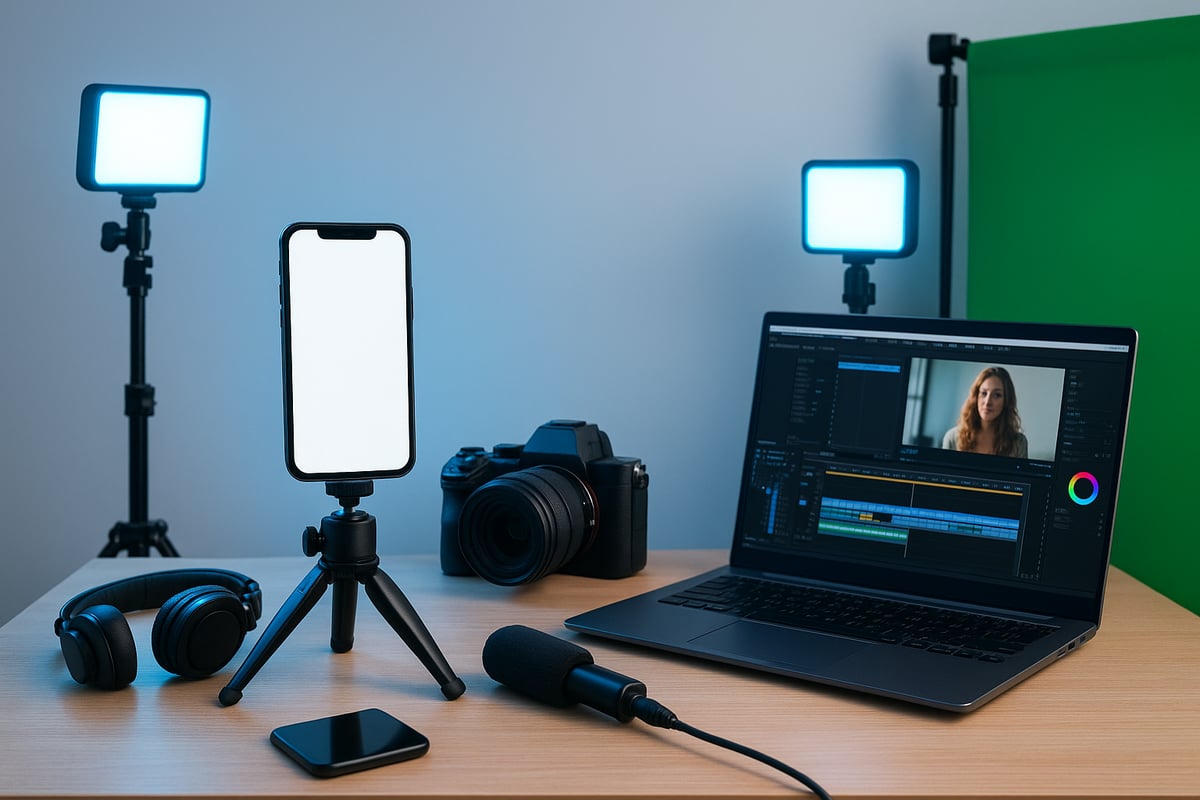
Must-Have Equipment for Modern Creators
Today’s creators face a pivotal choice: smartphone or mirrorless camera? Modern smartphones, like the iPhone 16 Pro, offer cinematic modes, 8K recording, and built-in stabilization. Mirrorless cameras deliver unmatched control and lens flexibility, perfect for creators who crave a professional touch.
Accessories are the secret sauce of videography for social media. Gimbals ensure buttery-smooth shots, while compact tripods make on-the-go shooting a breeze. Clip-on microphones deliver crisp audio in noisy environments. LED lighting kits and portable green screens allow creators to film anytime, anywhere, regardless of natural light or background.
Here’s a quick comparison of essential gear:
| Gear Type | Best For | Top Pick (2025) |
|---|---|---|
| Smartphone | Portability, speed | iPhone 16 Pro |
| Mirrorless Camera | Depth, pro quality | Sony ZV-E1 |
| Gimbal | Smooth movement | DJI Osmo Mobile 7 |
| Microphone | Clear audio | Rode Wireless GO III |
| Lighting Kit | Consistent lighting | Neewer RGB Panel Kit |
| Green Screen | Versatile backgrounds | Elgato Collapsible |
The surge in mobile video creation is backed by hard data. According to Social Media Video Statistics 2025, over 80 percent of creators now rely on their smartphones for daily content, showing just how vital these tools have become.
Cutting-Edge Editing and Production Software
Editing is where magic happens in videography for social media. AI-driven editors like Adobe Premiere Pro’s AI suite and CapCut automate tedious tasks, letting creators focus on their stories. Mobile-first apps, such as Descript, empower creators to edit on the fly, even during travel or events.
Cloud collaboration is a game-changer for teams. Platforms like Frame.io and Canva Teams allow for seamless feedback and remote teamwork. Automated captioning tools not only save time but also boost accessibility, ensuring videos reach wider audiences.
Key software for 2025 includes:
- Adobe Premiere Pro (AI tools)
- CapCut (mobile editing)
- Descript (voice-to-text editing)
- Canva Teams (graphic overlays)
- Frame.io (cloud collaboration)
With these tools, creators can polish their videos quickly and maintain a consistent brand style across all platforms.
Workflow Automation and Content Management
Staying organized is essential in videography for social media. Scheduling tools like Later, Buffer, and Hootsuite help creators post at peak times without missing a beat. Asset management systems keep video files, graphics, and scripts accessible for teams and agencies.
Integrating analytics dashboards into your workflow gives instant feedback on what works. Tools like Zapier automate uploads and reporting, freeing up time for creativity and experimentation.
A streamlined workflow might look like this:
- Batch shoot content for the week
- Edit using cloud-based software
- Schedule posts with Buffer
- Monitor analytics in real time
- Automate repetitive tasks with Zapier
The right workflow keeps content flowing and engagement high, even as trends shift.
Staying Budget-Conscious Without Compromising Quality
You don’t need a Hollywood budget to excel at videography for social media. Affordable gear, like mid-range smartphones and entry-level mirrorless cameras, now deliver pro-level results. Free and low-cost software options, such as InShot, VN Video Editor, and Lightworks, empower creators at every stage.
A quick glance at top free apps in 2025:
| App | Platform | Best Feature |
|---|---|---|
| InShot | iOS, Android | Easy trimming, filters |
| VN Video Editor | iOS, Android | Multi-layer editing |
| Lightworks | Windows, Mac | Pro-grade features |
By mixing smart gear choices with free tools, anyone can create eye-catching content. The heart of videography for social media is creativity, not cost.
Creative Planning: Storytelling, Scripting, and Pre-Production
Every standout social video begins with a spark—a vision that connects brand, message, and audience. Creative planning is where that vision takes shape, setting the stage for impactful videography for social media that resonates in 2025.
Crafting a Social-First Video Strategy
The foundation of effective videography for social media is a clear, audience-driven strategy. Start by defining what success looks like—whether it is boosting brand awareness, driving engagement, or converting viewers into loyal fans.
Next, dig deep into your audience’s world. What platforms do they love? What content makes them pause, laugh, or share? Align your video ideas with your brand’s voice and values, ensuring every story you tell supports your larger mission.
Brands that weave storytelling into their videography for social media often foster stronger communities. Consider how you can create not just content, but a narrative that invites viewers to become part of your brand’s journey.
Storyboarding and Scripting for Maximum Impact
Once your strategy is set, it is time to bring ideas to life on paper. Storyboarding lets you visualize each scene, mapping out camera angles, transitions, and pacing. Use digital tools to make it easy to collaborate and adjust in real time.
Scripts are the backbone of videography for social media, especially when attention spans are short. Write concise, punchy scripts that hook viewers within the first three seconds. Use clear calls to action, and always keep your platform’s unique style in mind.
Viral TikTok scripts, for example, often blend humor with relatability, driving high retention. Experiment with different approaches to discover what resonates with your own community.
Planning for Platform-Specific Formats
Every social platform is its own stage, with unique formats and rules. For videography for social media, tailor your content to fit vertical or horizontal layouts, time limits, and interactive features like polls or stickers.
Short-form video dominates on TikTok and Instagram Reels, while YouTube Shorts and Facebook Stories require their own creative tweaks. Use insights from Social Video Marketing Changes by Platform 2025 to understand how strategies shift across platforms.
Plan content calendars to batch-produce videos, ensuring consistency and saving valuable time. With the right workflow, you can maximize your impact everywhere your audience spends their time.
Organizing Shoots for Efficiency
Preparation is the secret weapon of pros in videography for social media. Scout locations that match your brand’s vibe, and secure any needed permissions early. Create detailed shot lists and schedules for talent, crew, and gear.
Batch filming is a game-changer. By shooting multiple videos in one session, you streamline production and maintain a cohesive look across your content. Many successful influencers swear by this method to keep their feeds fresh and engaging.
Efficiency in organizing shoots means more time for creativity and less stress when deadlines loom. A well-planned shoot makes the entire videography for social media process smoother.
Legal and Ethical Considerations
Great videography for social media is not just about creativity—it is about responsibility. Always secure rights to music, footage, and images before sharing. Platforms have strict guidelines, and copyright strikes can derail even the best campaigns.
Be mindful of representation in your stories. Ensure diversity and ethical storytelling, giving voice to all perspectives. Stay up to date with evolving copyright and privacy laws, especially as platforms change their policies.
Taking these steps protects your brand and builds trust with your audience, making your videography for social media both impactful and sustainable.
TIME&SPACE: Real-Time Event Videography for Social Media
For conscious leaders and organizations, real-time event videography for social media is a game-changer. TIME&SPACE empowers brands to capture and share professional video content instantly, driving engagement and deepening community connections.
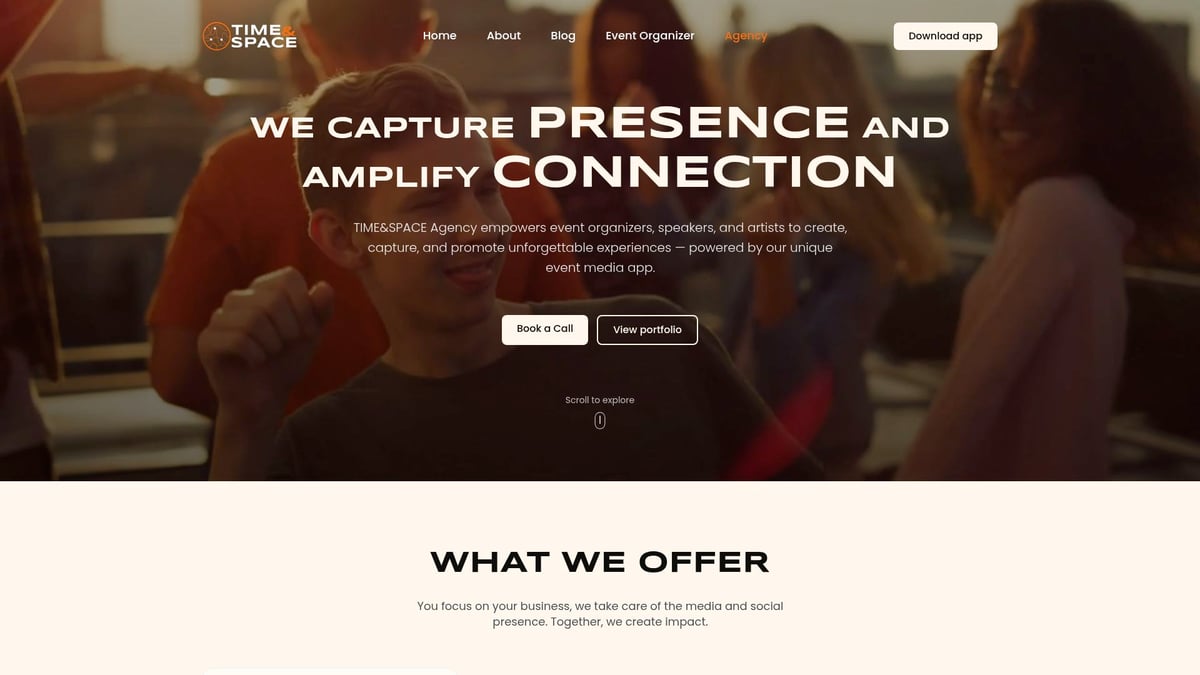
The TIME&SPACE App enables on-site teams to deliver polished videos in real time, amplifying reach and ticket sales for events. Their heart-led creative strategy and AI-powered workflows set them apart, delivering speed and authenticity.
Case studies show how purpose-driven brands have transformed event coverage, turning moments into powerful stories. In a world where immediacy matters, TIME&SPACE brings videography for social media into the now.
Shooting Social Media Video: Techniques and Best Practices
The art of videography for social media is a dynamic dance between creativity and technical skill. Each shot tells a story, and every detail shapes how your audience feels, connects, and responds. In a world where social video dominates user attention, the difference between ordinary and unforgettable comes down to the techniques you master and the best practices you follow.
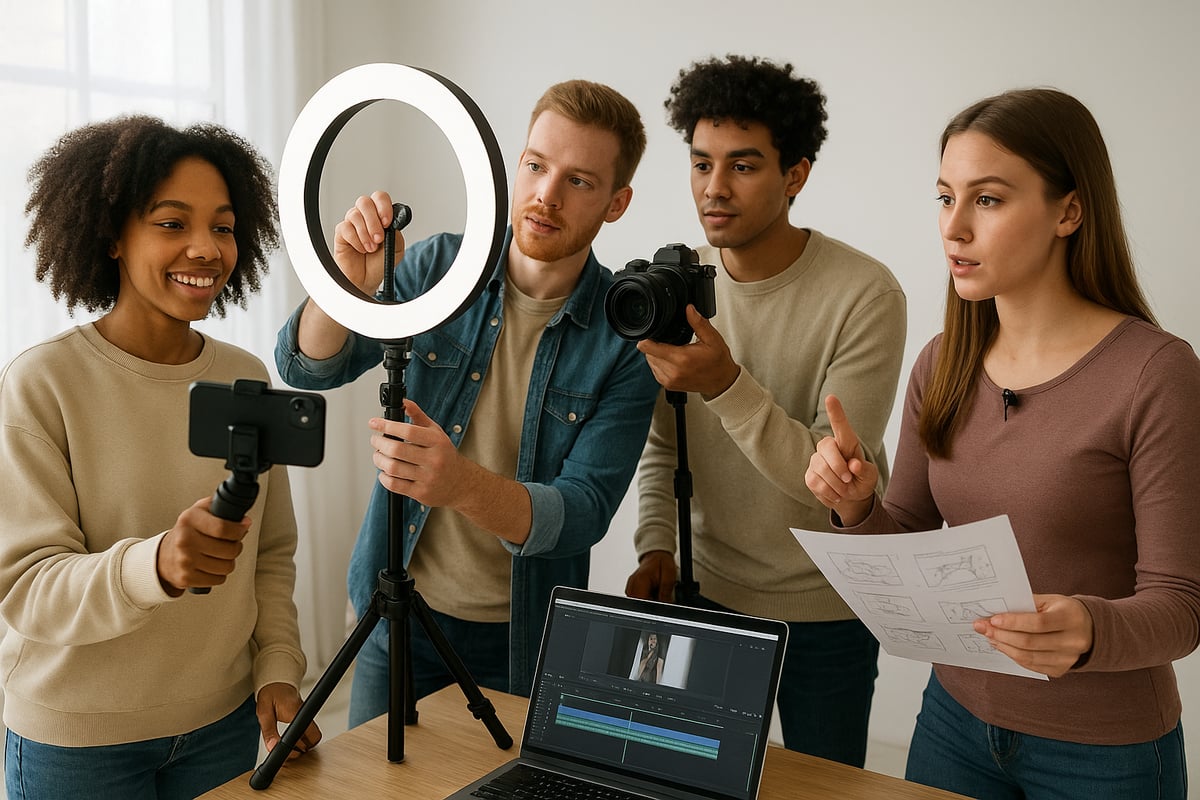
Lighting, Composition, and Framing for Social Platforms
Lighting is the silent storyteller in videography for social media. Natural light, streaming through a window, can create a soft, authentic look that audiences love. If you are filming at night or in a dim space, use affordable LED panels or ring lights to brighten faces and reduce harsh shadows.
Composition matters just as much. The rule of thirds guides viewers' eyes and keeps your subject front and center, especially important for mobile-first content. Vertical framing is now the norm, so fill that space with close-ups and dynamic movement.
| Lighting | Pros | Cons |
|---|---|---|
| Natural Light | Authentic, flattering | Unpredictable, time-limited |
| LED/Ring Light | Consistent, adjustable | May require power source |
Good framing and lighting make videography for social media stand out on crowded feeds.
Audio Quality and Accessibility
Clear sound brings your story to life. Use a clip-on lavalier or shotgun microphone for sharp dialogue and fewer distractions. If background noise sneaks in, most editing apps let you clean up audio fast.
Accessibility is equally important in videography for social media. Add captions and subtitles, not just for inclusivity, but because many people watch without sound. In fact, 80 percent of TikTok videos with captions see higher completion rates.
Key tips for better audio:
- Test your setup before recording.
- Record in quiet spaces when possible.
- Always review audio during editing.
These small steps help your message reach more viewers.
Maximizing Engagement with On-Camera Presence
Your presence on camera can turn viewers into loyal fans. Authenticity is the secret ingredient in videography for social media. Speak as if you are chatting with a friend, and let your personality shine through.
Use prompts or questions to spark interaction. Calls to action, like “Comment your favorite tip below,” invite viewers to join your story. Collaborate with influencers or guests for fresh perspectives and wider reach.
Popular formats like “duet” or “reaction” videos on TikTok create community and boost engagement. When you show up as your real self, your audience feels it and responds.
Filming for Different Social Platforms
Each platform has its own visual language, making versatility essential in videography for social media. Instagram Reels, TikTok, YouTube Shorts, and Facebook Stories all favor vertical video, but the style and pacing differ.
For Instagram, focus on eye-catching visuals in the first three seconds. TikTok rewards humor, trends, and authenticity. YouTube Shorts leans into concise storytelling, while LinkedIn values polished, informative clips.
It is no surprise that the share of time spent on social video in the U.S. 2025 continues to climb, reflecting the growing importance of platform-specific strategies.
Batch filming content in different formats helps you stay ahead and maximize reach.
Troubleshooting Common Challenges
Even the best plans face hiccups. In videography for social media, low lighting, unwanted noise, or tight spaces can threaten your shoot. Here are quick fixes:
- If lighting is poor, use a portable LED or bounce light off a white surface.
- For background noise, record a short “room tone” and use it to mask problem spots in editing.
- When space is limited, shoot close-ups and get creative with angles.
If your footage fails, repurpose behind-the-scenes moments or graphics to fill the gap. Flexibility turns challenges into opportunities, helping you keep your content fresh and your process stress-free.
Editing, Optimizing, and Publishing for Maximum Impact
Cutting, tweaking, and sharing your video is where the magic happens. These steps transform raw footage into a scroll-stopping story. In the world of videography for social media, what you do after the camera stops rolling truly sets your content apart.
Step 1: Editing for Speed and Story
Every second counts in videography for social media. Start by reviewing your footage and picking the best takes. Keep your story tight and cut out anything that drags.
Use AI-powered editing tools like CapCut or Adobe Premiere Pro’s new features for auto-editing and smart trimming. These help you move fast without losing quality. Add dynamic graphics, transitions, and overlays to keep the energy high.
Try templates and presets to speed up your workflow. For example, editing a 60-second reel in under 10 minutes is now possible with the right tools. Remember, in videography for social media, a snappy, well-edited video wins every time.
Step 2: Optimizing for Platform Algorithms
If you want your videography for social media to reach the right eyes, you need to play by the platform’s rules. Each platform’s algorithm has its quirks. Focus on retention rates, engagement signals, trending hashtags, and eye-catching thumbnails.
Write punchy titles and use metadata and keywords that match your audience’s searches. A/B test different hooks and thumbnails to see what gets more clicks.
For TikTok, optimize your videos to land on the “For You” page by starting strong and using relevant music. In a sea of content, smart optimization is your secret weapon in videography for social media.
Step 3: Accessibility and Inclusivity
Accessibility is no longer optional in videography for social media. Most viewers watch with the sound off, so always add accurate captions and subtitles. Use automated captioning tools to save time and boost reach.
Go further by adding alt text and visual descriptions for visually impaired users. Make sure your videos represent diverse voices and stories. Brands that embrace accessibility see higher engagement and positive feedback.
Here’s a quick example of a caption:
[Text on screen]: “Ready for a behind-the-scenes look? Let’s dive in!”
Inclusive videography for social media opens your message to everyone.
Step 4: Publishing and Promotion Strategy
Timing and strategy are everything in videography for social media. Use scheduling tools like Later or Buffer to post when your audience is most active. Batch content creation lets you stay consistent without burning out.
Cross-post your videos across platforms to maximize reach. Repurpose content by editing longer videos into shorter clips for Reels, Shorts, or Stories. Amplify your reach with influencer collaborations and targeted paid promotions.
Coordinated launches, where you release videos simultaneously on multiple platforms, can create buzz and drive engagement. Make every upload count with a smart publishing plan.
Step 5: Monitoring Performance and Iterating
The journey of videography for social media doesn’t end at publishing. Dive into your analytics dashboard to track views, watch time, and engagement rates. Use these insights to understand what resonates.
A/B test different video lengths, hooks, or styles to see what works best. Adjust your strategy based on the data. For example, some brands have doubled their engagement by refining their video length or trying a new call to action.
Continuous improvement is your edge in videography for social media. Stay curious, keep experimenting, and let your data guide you toward even greater results.
Future Trends and Predictions in Social Media Videography
Picture a world where videography for social media evolves at the speed of imagination. As we move into 2025, creators and brands are standing on the edge of a new era—one powered by technology, creativity, and connection. Let’s explore the shifts that will shape how stories are told, shared, and experienced on the world’s most popular platforms.
The Rise of Generative AI and Automation
Generative AI is rewriting the playbook for videography for social media. Imagine uploading a rough script and receiving a fully edited video, complete with captions, transitions, and personalized touches—all in minutes. AI tools now write scripts, suggest shot lists, and even generate highlight reels from hours of footage.
Brands are using AI to tailor content for different audiences, creating countless variations at scale. Automated editing not only saves time but also helps creators stay agile in a fast-paced environment. As these tools become more intuitive, anyone with a vision can bring professional-quality videos to life.
AI-driven workflows are becoming standard, making it easier to experiment and iterate quickly. This empowers storytellers to focus on creativity rather than getting lost in tedious edits.
Immersive Video Experiences: AR, VR, and 360-Degree Content
Immersive technology is transforming videography for social media into an interactive adventure. Augmented reality (AR) filters are now part of everyday storytelling, adding playful effects or informative overlays that grab attention.
Virtual reality (VR) and 360-degree videos are bringing viewers directly into the heart of the action. Imagine touring a music festival, exploring a boutique, or joining a yoga class—all from your phone. Brands are tapping into these formats to create experiences that feel personal and unforgettable.
Interactive elements, like clickable hotspots or real-time polls, invite viewers to participate rather than just watch. The result? Deeper engagement and a sense of belonging that traditional video can’t match.
Shoppable and Interactive Video Commerce
Shopping is no longer a separate activity—it’s woven into the fabric of videography for social media. Platforms like TikTok and Instagram now let users buy products directly from videos, turning inspiration into action with a single tap.
Creators are hosting live shopping events, demonstrating products in real time and answering questions on the spot. Interactive features like shoppable tags and swipe-up links make it easy for viewers to explore and purchase without leaving the app.
This seamless blend of entertainment and commerce is changing how brands connect with their audiences. As shoppable video becomes the norm, expect the lines between content and commerce to blur even further.
Community-Driven Content and Co-Creation
Videography for social media is no longer a solo act. Brands and creators are inviting their communities to join the storytelling process. User-generated content—duets, reactions, and hashtag challenges—drives viral trends and builds authentic connections.
Collaborative campaigns empower fans to become co-creators, sharing their own perspectives and experiences. Brands that foster this sense of belonging see stronger loyalty and higher engagement.
Shared video experiences, like stitching together clips from around the world, turn audiences into active participants. In 2025, the most memorable stories will be those told together.
Sustainability and Ethical Storytelling
As audiences grow more conscious, sustainability is becoming a core value in videography for social media. Creators are rethinking production practices—using eco-friendly gear, minimizing waste, and choosing digital-first workflows that reduce travel and resource use.
Ethical storytelling is also in the spotlight. Brands are expected to represent diverse voices, share honest narratives, and be transparent about their impact. Videos that highlight sustainability efforts or feature real stories resonate deeply with viewers.
By prioritizing ethics and the planet, creators can inspire positive change and build trust with their communities.
Preparing for What’s Next
The future of videography for social media belongs to those who stay curious and adaptable. Platforms will keep evolving, and new tools will emerge. The most successful creators are those who embrace continuous learning, test fresh ideas, and aren’t afraid to pivot.
Set aside time to explore new formats, experiment with AI-powered features, and listen to your audience’s feedback. Early adopters often gain an edge, spotting trends before they go mainstream.
Above all, remember that the heart of videography for social media is storytelling—connecting people through shared moments, emotions, and experiences. The next chapter is yours to write.
After exploring the creative landscape of social media videography in 2025—from the magic of real-time event sharing to the power of authentic, purpose-driven storytelling—maybe you’re imagining what all this could look like for your own brand or event. If you’re ready to connect your story with your audience in a way that feels real and makes a difference, let’s talk about how we can help bring your vision to life with speed, heart, and strategy. You don’t have to figure it out alone—Book a discovery call and let’s create something unforgettable together.
Subscribe to our newsletter
We will keep it short and relevant, once a month... and soon we will replace the newsletters!

